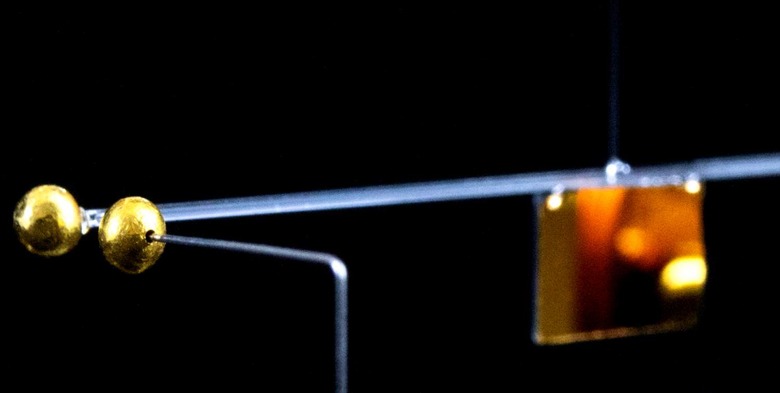This Modern Take On A 200 Year Old Gravity Experiment Could Help Find Dark Matter
The smallest gravitational force ever recorded has been measured, with scientists upturning common assumptions about just what counts as "too small" to be quantified. Although all objects demonstrate some sort pull based on their mass, we're most familiar with – and feel the impact primarily from – planetary bodies, like the gravity Earth exerts upon us.
That doesn't mean other, far smaller objects don't have gravitational fields of their own, just that so far there's been no ready way to measure them. It's no idle curiosity, either: with a more nuanced understanding of the tiniest forces of gravity, scientists could go hunting for modern day mysteries such as dark matter or dark energy.
It came down to a group of quantum physicists, led by Markus Aspelmeyer and Tobias Westphal of the University of Vienna and the Austrian Academy of Sciences, and a cutting-edge twist on a very old experiment. The Cavendish method was first conducted at the end of the 18th century, with a foot-wide lead ball weighing over 350 pounds brought near a torsion pendulum.
That has two masses suspended by a wire and otherwise free to rotate: Cavendish showed that the gravitational force of the lead ball was sufficient to deflect the pendulum. In the process, he and others countered assumptions that only planets and similarly astronomical objects had any gravitational pull of their own.

The modern-day version of the experiment went much, much smaller. The Vienna researchers used a 2 mm diameter sphere made of gold, and weighing just 90 mg, in place of the lead ball. Their torsion pendulum, meanwhile, was a 2-inch glass rod just half a millimeter thick, dangling from a glass fiber, and with more gold spheres attached at each end. A laser was employed to track any movement.
"We move the gold sphere back and forth, creating a gravitational field that changes over time," Jeremias Pfaff, a researchers on the team, explains. "This causes the torsion pendulum to oscillate at that particular excitation frequency."
The actual movement itself was just a few millionths of a millimeter, and at that level the group was forced to take steps to avoid potential influences of movement from sources you wouldn't ordinarily think about. Electrostatic forces were foiled with a conductive shield placed between the masses, for example, and the pendulum was suspended in a vacuum chamber. However, some of the other factors could only be addressed with unusual office hours.
"The largest non-gravitational effect in our experiment comes from seismic vibrations generated by pedestrians and tram traffic around our lab in Vienna," co-author Hans Hepach explains. "We therefore obtained the best measurement data at night and during the Christmas holidays, when there was little traffic."
Though interesting in its own right, the research – published today in Nature – also has broader applications. The team is now working on looking at gravitational fields of masses thousands of times lighter than the gold balls used in this experiment, with the eventual goal of being able to calculate truly tiny forces. That might allow the presence of dark energy or dark matter, believed to be instrumental in how the universe formed, to be identified, from the way that it changes the behavior of gravity.
[Images: Tobias Westphal / Arkitek Scientific and Barbara Mair]
